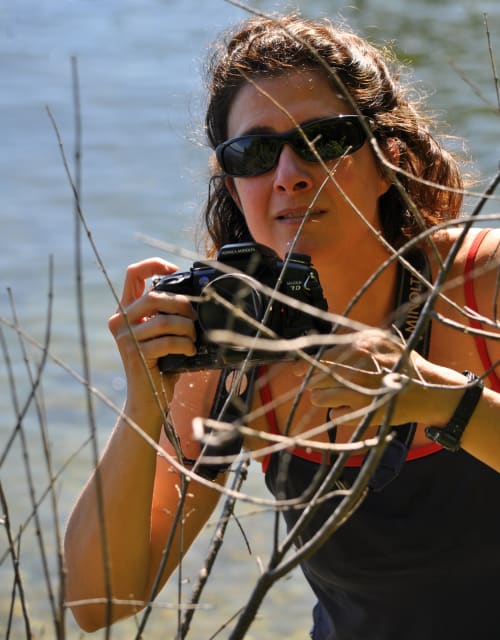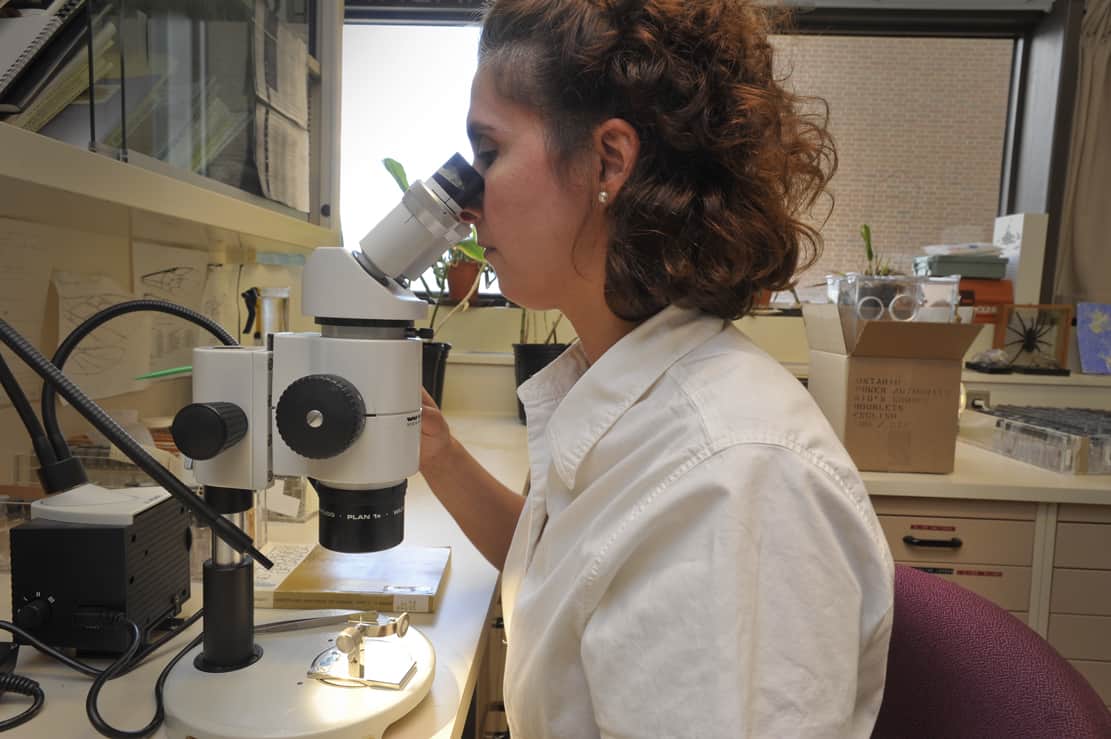Antonia Guidotti is an Entomology Technician at the Department of Natural History in the ROM. We asked her what it’s like, and what she loves (and loathes) about her profession.
SDTC: What does a typical day look like for you, starting from when you wake up – to heading to bed?
AG: 7 a.m. Wake up, eat breakfast, prepare lunch for my younger son and myself, wake kids.
8:10 a.m. Ride bike to work most of year, TTC on rainy and snowy/salty days.
8:30 a.m. Arrive at ROM; check email. One of the best things about my job is that every day is different. There is no ‘typical’ day.
Tasks I will do in a given day may include:
I will often respond to any public inquiries about insects that I have received. I do about 200 identification requests per year. A recent example: received an image of a possible “monster” found suspended in a back yard fence. I identified it as the cocoon of a moth in the family Saturniidae (giant silk moths). Since there are several species in Ontario, I couldn’t identify it to species. I responded that it is adapted to our cold winters and would emerge in the spring unless it was parasitized. The person has an allergy to wasp venom and was concerned that if a wasp emerged, it might be dangerous to her. I reassured her that parasitic wasps do not sting.
Through the warmer months, I occasionally receive media requests for information on different insects and arachnids. This can be anything from bed bugs to black widow spiders to midges or yellowjacket wasps, etc. A typical late August example: “Why are there so many yellow jackets this year?”
Once a week I feed the tarantulas and Blue-leg centipede in the live room.
Galleries – part of a gallery is being redone and I am providing the “insect” content. One of the tasks is determining the message of the bee panel. I have selected a number of species to include. Now I have to source images of Ontario bumblebees (probably on-line) and locate specimens – either from our collection or from colleagues. I may have to go out and collect some in the spring.
Assist Curatorial Research – One recent task: paint rings on slides for curator’s research on tiny parasitic wasps of Central and North America.
Supervise/train students and volunteers – we have 5 University of Toronto biology undergraduates at the moment. They come in for a few hours a week, one or two each day. I ensure that they have material to sort and make and print labels for the specimens. I verify that specimens are correctly sorted.
Collection work – We loan specimens to experts around the world who study and identify them. When they are returned, the specimens need to be databased and labelled before being returned to the collection. One entomologist in Ottawa studies dung beetles, so we send him all the dung beetles that we collect.
Last year at this time, I was fully engaged in putting together the ROM Field Guide to Butterflies of Ontario, sourcing the last images, editing and reviewing text, ensuring accuracy of information, consistency, etc.
There are some tasks that fall under the category of extra (but fun) volunteer work. I am the Program Coordinator for the Toronto Entomologists’ Association; this involves booking speakers and rooms for their monthly meetings. I was also elected as a Director to the Entomological Society of Ontario Board. Last year that involved organizing the Annual General Meeting.
4:30 Bike or TTC home. Pick up son from daycare, make dinner, eat, clean up. Help with homework. Occasionally, play board games with kids. Year round- I play soccer on a women’s team once a week. In winter, I take the boys to soccer training (and help out with practice) once a week. In summer, I co-coach both boys’ soccer teams. So basically summer is soccer 4 nights a week when we aren’t travelling or camping.
Bed by 10:30 if not earlier!

SDTC: What made you want to get into this line of work?
AG: My BSc is in Toxicology and Zoology. I have always loved nature and am concerned about our impact on the environment. I worked for a while in environmental assessment and planning. When I was hired on a short term contract in the Entomology Department at the ROM, I enjoyed it so much, I stayed. I volunteered and completed my Master’s here and worked on additional contracts before being hired full time.
SDTC: Have you always loved working with insects?
AG: I have always loved nature and insects are a big part of it. When I first started working here on a contract, I was fascinated by the diversity in colour and shape and size of the insects I was sorting. A microscope is a powerful tool and revealed a world that I had only vaguely thought about before. During that time, I realized that I really enjoyed this work and hoped that I could do if for a living. I was hired full-time 6 years later!
SDTC: What characteristics should one cultivate to do this job well?
AG: Attention to detail is high on the list. Organizational skills. Patience and endurance- many projects are longterm, and ongoing. Collection management is never-ending in entomology.
SDTC: Favourite part of your job? Least favourite?
AG: Lots of favourites: meeting and working with interesting people, the low-stress atmosphere, successfully completing projects, correctly identifying species, helping people solve insect problems in their homes, working a 4 day week….
Least favourites: 1. My inability to help people with delusional parasitosis- a condition where someone thinks they are being bitten but there is no insect or arachnid found. 2. I am not fond of preparing specimen loans to mail out; I’m not very good at wrapping!
SDTC: What’s been your most memorable project?
AG: There are few. I was pleased to have my Master’s thesis published with the four wasp species that I described and named. That was very important to me. I really enjoyed working on the ROM Field Guide to the Butterflies of Ontario and was thrilled when it was published last year. It is the first butterfly guide for all of Ontario and we are very proud of it. It was a pleasure to work on the Butterflies of Toronto (a City of Toronto Biodiversity Series publication); the working group included so many fantastic and knowledgeable volunteers.
SDTC: Any warnings or advice for people who want to find work in your field?
AG: It is very difficult to find full time work in the sciences. Volunteering in a place where you would like to work sometimes helps, accepting less interesting jobs related to the field may lead to more opportunities. I recommend joining associations of individuals with similar interests.
SDTC: What do you see yourself doing five years from now?
AG: I love my job and expect that I will be still here working with insects.



 Follow Us On Instagram
Follow Us On Instagram
